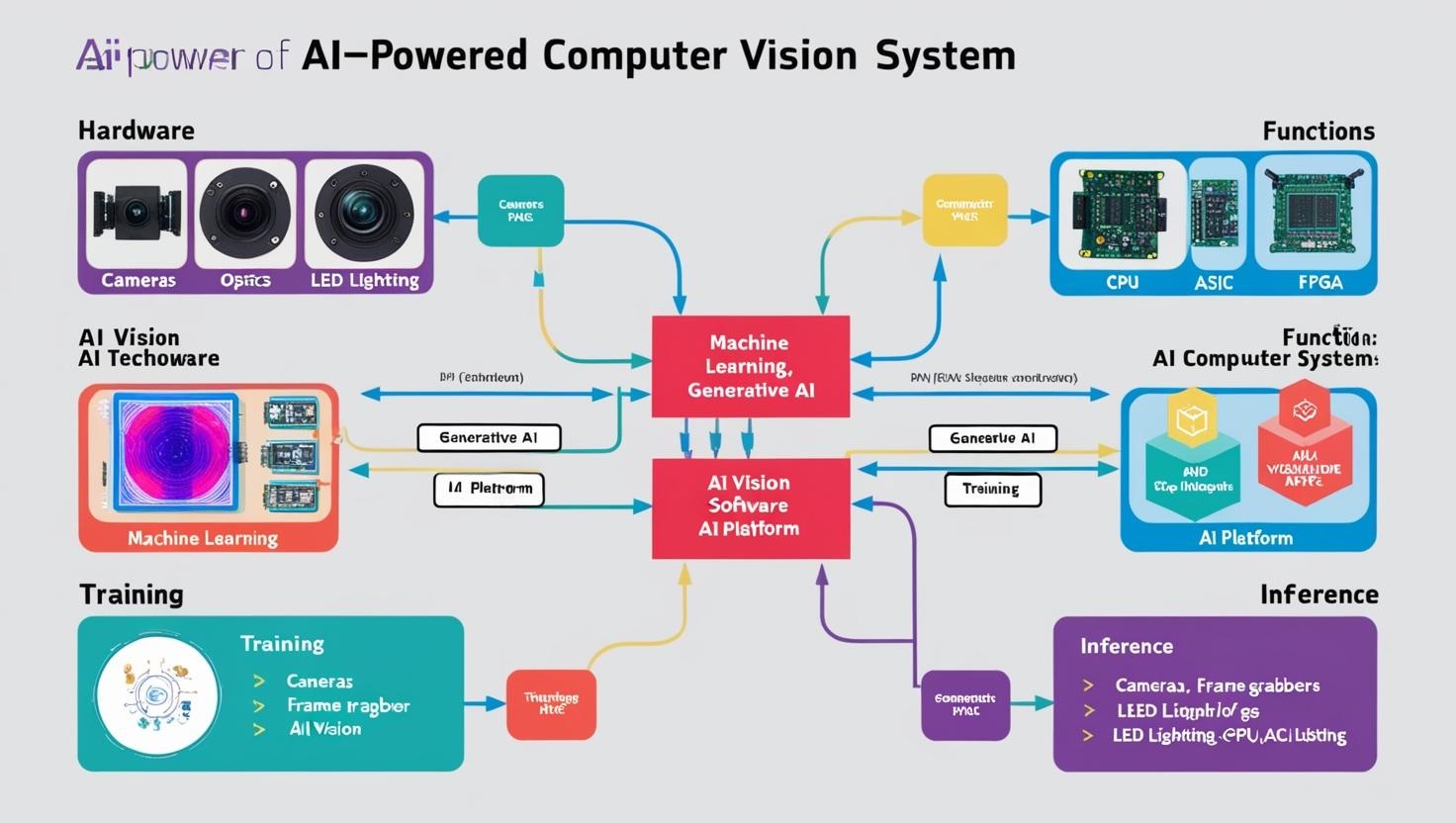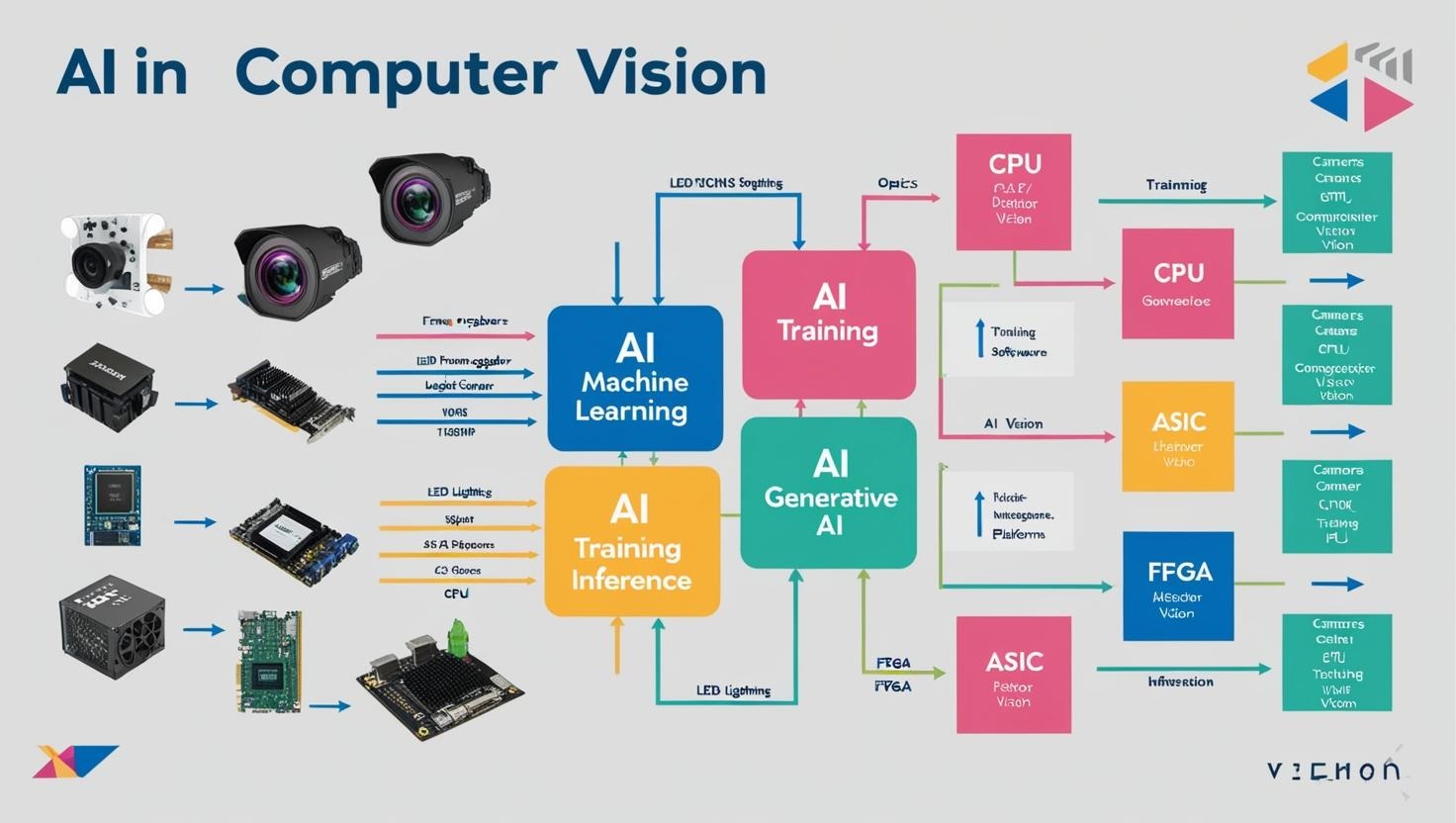In the fast-evolving world of artificial intelligence (AI), one of the most groundbreaking advancements is the development of AI vision technologies. These technologies, often referred to as computer vision, allow machines to interpret and understand visual data in a way that was once thought to be exclusive to humans. AI vision is enabling machines to “see” and process images and videos, making them smarter, more intuitive, and capable of performing complex tasks with remarkable accuracy.
From autonomous vehicles to healthcare diagnostics and industrial automation, AI vision technologies are revolutionizing industries, pushing the boundaries of what machines can achieve. In this article, we will explore how AI vision is reshaping the landscape of technology, its key applications, and why it’s the key to developing smarter, more intelligent machines.
What is AI Vision?
AI vision, also known as computer vision, is a subfield of artificial intelligence that enables machines to interpret and analyze visual data (images, videos, etc.). This technology mimics human vision by using algorithms and machine learning models to recognize patterns, identify objects, and understand scenes within visual inputs. Computer vision algorithms process visual information in the same way that the human brain processes sight, but at a much faster and often more accurate rate.
In practice, AI vision technologies use deep learning models, particularly convolutional neural networks (CNNs), to analyze and classify images and videos. By training these models on large datasets, AI systems can “learn” to identify objects, detect anomalies, recognize faces, and even predict future events based on visual data.
The global Al in computer vision market is projected to reach USD 63.48 billion in 2030 from USD 23.42 billion in 2025; it is expected to grow at a CAGR of 22.1% from 2025 to 2030.
How AI Vision is Powering Smarter Machines
AI vision is at the heart of the transformation towards more intelligent machines, and its impact is felt across several domains. Below, we delve into the key areas where AI vision is pushing the boundaries of machine capabilities:
1. Autonomous Vehicles
One of the most high-profile applications of AI vision is in autonomous vehicles. For a self-driving car to navigate roads safely, it needs to “see” its environment and make decisions based on that data. AI vision systems in autonomous vehicles analyze real-time visual data from cameras, sensors, and LiDAR to identify pedestrians, other vehicles, road signs, traffic lights, and obstacles.
This real-time perception system is crucial for safe driving and collision avoidance. By continuously interpreting visual data, AI vision enables autonomous cars to respond quickly to changing conditions on the road, making them capable of driving without human intervention.
2. Healthcare and Diagnostics
In healthcare, AI vision is revolutionizing diagnostics and patient care. Medical imaging technologies, such as X-rays, MRIs, and CT scans, generate vast amounts of visual data. AI vision technologies can be used to analyze these images, identify abnormalities, and assist doctors in diagnosing diseases such as cancer, heart conditions, and neurological disorders.
For example, AI-powered diagnostic tools can detect tumors in radiology images with incredible accuracy, sometimes even identifying problems at earlier stages than a human doctor could. In ophthalmology, AI vision is used to analyze retina scans and detect diseases like diabetic retinopathy, allowing for early intervention and better patient outcomes.
Download PDF Brochure @
https://www.marketsandmarkets.com/pdfdownloadNew.asp?id=141658064
3. Retail and Customer Experience
AI vision is transforming the retail industry by enabling smart stores and creating more personalized customer experiences. Computer vision systems in retail environments can track customer behavior, analyze foot traffic, and even predict future purchasing patterns. These systems help businesses optimize store layouts, manage inventory, and offer targeted promotions.
Moreover, AI vision is being used to power autonomous checkout systems where customers can pick up products and simply walk out of the store without needing to go through a traditional checkout process. Cameras and sensors use AI to detect the items a customer selects and automatically charge them, eliminating the need for manual intervention.
4. Manufacturing and Quality Control
In the manufacturing sector, AI vision is playing a crucial role in improving production efficiency and quality control. Automated vision systems are capable of inspecting products for defects during the production process, ensuring that only high-quality products are shipped to customers.
By analyzing visual data from the production line, AI vision systems can identify flaws such as scratches, dents, or misalignments, often with greater precision than human inspectors. This real-time quality monitoring allows for quicker identification of problems, reducing waste and improving overall product consistency.
5. Smart Security Systems
AI vision is enhancing the effectiveness of security systems by enabling advanced surveillance and monitoring capabilities. Using AI-powered cameras, businesses and homeowners can rely on automated systems that can identify potential threats, such as unauthorized individuals, suspicious behavior, or security breaches.
AI vision technologies in security cameras can analyze faces, movements, and activities to improve threat detection. These systems can also recognize and track individuals, reducing the need for human intervention in monitoring security footage and increasing response times in case of a security incident.
Key Benefits of AI Vision Technologies
AI vision technologies offer a host of advantages that make machines smarter and more capable. These benefits are driving innovation in multiple industries:
1. Enhanced Accuracy and Efficiency
AI vision systems can process and analyze visual data with incredible accuracy, often outperforming humans in terms of speed and precision. This enables machines to make more informed decisions based on visual inputs, ensuring that tasks are completed efficiently and correctly.
2. Automation and Cost Reduction
By automating tasks that traditionally required human input, AI vision helps reduce operational costs. Whether it’s analyzing medical images, monitoring a manufacturing process, or running an autonomous vehicle, AI vision technologies can perform these tasks with minimal human oversight, freeing up resources for other important areas.
3. Real-Time Decision Making
AI vision provides real-time insights that allow machines to make quick decisions based on up-to-the-second visual data. This capability is essential in applications like autonomous driving, real-time security monitoring, and predictive maintenance, where swift reactions to changing conditions can make all the difference.
4. Scalability and Adaptability
AI vision technologies are highly scalable and can be adapted to a wide range of industries. Whether it’s identifying defects in a production line, diagnosing diseases in medical imaging, or powering facial recognition for security, AI vision systems can be tailored to suit specific needs, making them versatile across industries.

AI in Computer Vision Industry
The Future of AI Vision Technologies
The future of AI vision technologies is bright, with rapid advancements expected in the coming years. Some of the key trends shaping the future of AI vision include:
- Integration with 5G Networks: As 5G technology becomes more widespread, AI vision systems will benefit from higher bandwidth and lower latency, enabling faster, more efficient real-time decision-making and data processing.
- Edge Computing: Edge AI vision systems will allow for faster data processing directly at the source, reducing the need for cloud-based processing and enabling quicker responses in real-time applications.
- Improved Human-Machine Collaboration: AI vision will continue to enhance collaboration between humans and machines, helping machines understand human gestures, expressions, and actions in a more intuitive way.
AI vision technologies are a key enabler of smarter, more intelligent machines that can see, understand, and interact with the world around them. With applications across industries like autonomous driving, healthcare, manufacturing, and security, AI vision is changing the way machines function and opening new possibilities for innovation. As AI vision continues to evolve, we can expect even greater advancements that will drive efficiencies, enhance safety, and create more personalized, automated experiences in the digital world.
In short, AI vision is not just the future of machines—it’s the future of how we interact with technology in a visual and intuitive way.
Frequently Asked Questions (FAQ) – AI Vision Technologies:
1. What is AI Vision?
AI Vision, also known as Computer Vision, is a field of artificial intelligence that enables machines to interpret and analyze visual data (images, videos, etc.). It uses algorithms and machine learning models to recognize patterns, objects, and scenes within visual inputs, allowing machines to “see” and understand the world much like humans do.
2. How does AI Vision work?
AI Vision works through machine learning techniques, especially convolutional neural networks (CNNs), that are trained on large datasets of images and videos. These algorithms learn to recognize patterns and make decisions based on the visual data they process. The more data the system is exposed to, the better it becomes at interpreting and analyzing visual inputs.
3. What are the main applications of AI Vision?
AI Vision is used in numerous industries and applications, including:
- Autonomous vehicles: For real-time object detection, collision avoidance, and navigation.
- Healthcare: Analyzing medical images such as X-rays, MRIs, and CT scans to assist in diagnoses.
- Retail: Powering smart stores, personalized customer experiences, and autonomous checkout systems.
- Manufacturing: Quality control and defect detection on production lines.
- Security: Advanced surveillance systems and facial recognition for security.
4. How is AI Vision transforming industries?
AI Vision is revolutionizing industries by automating tasks that traditionally required human vision, providing faster and more accurate results, improving safety, and enabling smarter decision-making. For example:
- In healthcare, it assists in diagnosing diseases with greater precision.
- In autonomous vehicles, it enables cars to navigate safely without human intervention.
- In retail, it improves customer service by offering tailored shopping experiences.
5. What are the benefits of AI Vision?
The main benefits of AI Vision include:
- Enhanced Accuracy: Machines can analyze and interpret visual data with greater precision than humans.
- Increased Efficiency: AI Vision can automate visual tasks, reducing human error and increasing operational efficiency.
- Real-Time Decision Making: AI Vision enables quick decision-making in time-sensitive situations like autonomous driving or real-time security monitoring.
- Cost Reduction: By automating processes, AI Vision reduces the need for human labor, leading to cost savings.
6. How does AI Vision improve security?
AI Vision improves security through real-time surveillance and anomaly detection. It can recognize faces, detect unusual activities, and identify potential threats automatically. This enables faster response times and reduces the reliance on manual monitoring. AI Vision can also be used in identity verification systems for access control.
7. What is the future of AI Vision?
The future of AI Vision looks promising with advancements in several areas:
- Integration with 5G Networks: AI Vision will benefit from higher bandwidth and lower latency, enabling faster, real-time data processing.
- Edge Computing: AI Vision systems will process data at the source (e.g., on devices) rather than relying on cloud-based systems, improving speed and efficiency.
- Human-Machine Collaboration: AI Vision will enhance interactions between humans and machines, enabling more intuitive and personalized experiences.
8. What industries are benefiting from AI Vision?
AI Vision is transforming several industries, including:
- Automotive: For autonomous vehicles and driver assistance systems.
- Healthcare: For medical image analysis and diagnostic assistance.
- Retail: For smart shopping experiences and inventory management.
- Manufacturing: For quality control and automation in production lines.
- Security: For surveillance, facial recognition, and threat detection.
9. What is the difference between AI Vision and traditional image processing?
AI Vision goes beyond traditional image processing by using machine learning to make sense of visual data. While traditional image processing techniques focus on basic tasks like filtering or enhancing images, AI Vision allows machines to recognize objects, interpret scenes, and learn from visual data in a way that mimics human perception.

